Page 8 of 354
Downloaded from www.Manualslib.com manuals search engine These symbols are on some of your controls:
Windshield
Washer Windshield
Defroster Windshield
Wiper
Ventilating
Fan
These symbols are used on warning and indicator lights:
Engine Coolant Battery Charging Fuel Temperature System
SHIFT
Brake Shift Light Anti-Lock
Brake
0
Off
Engine Oil
Pressure
vi i
Page 60 of 354
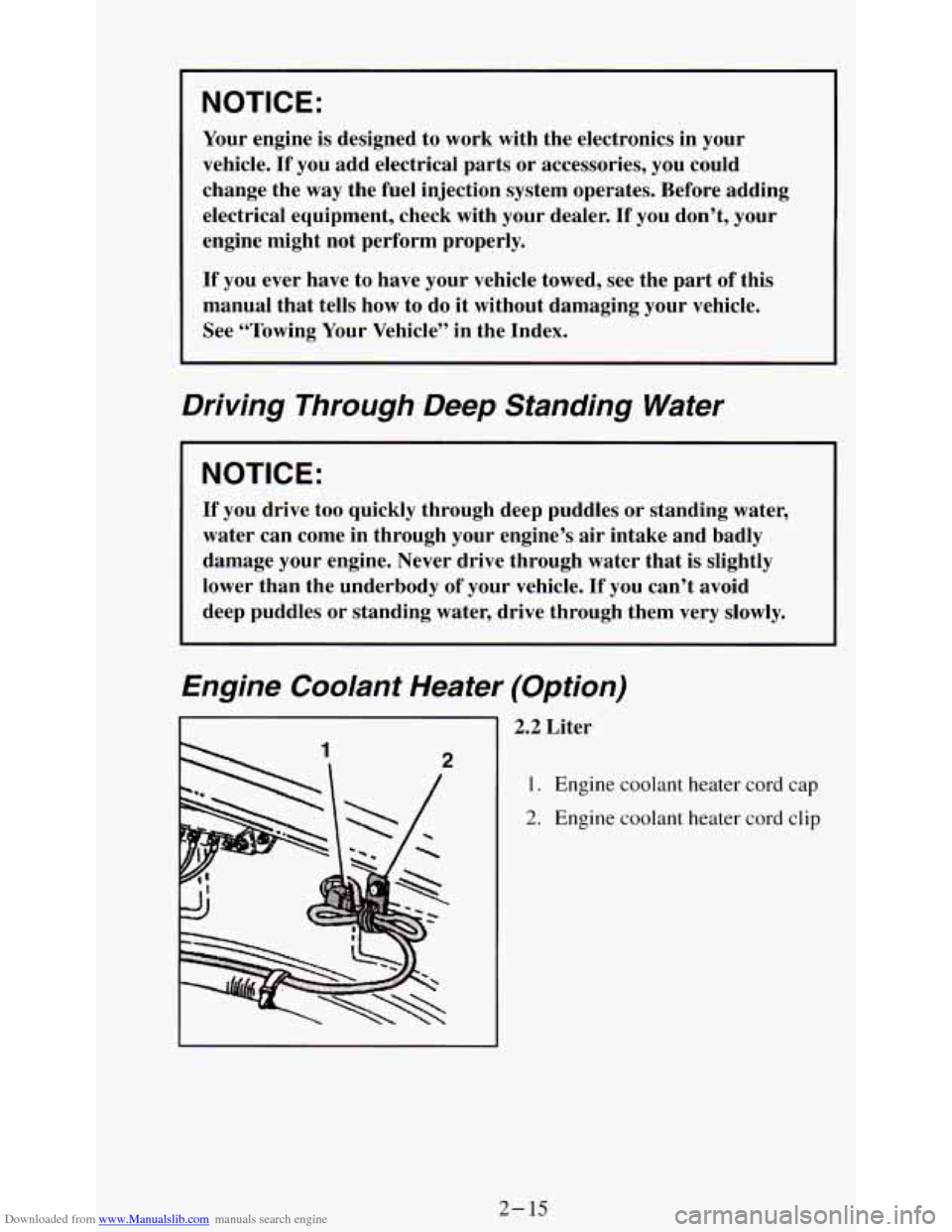
Downloaded from www.Manualslib.com manuals search engine NOTICE:
Your engine is designed to work with the electronics in your
vehicle.
If you add electrical parts or accessories, you could
change the way the fuel injection system operates. Before adding
electrical equipment, check with your dealer. If you don’t, your
engine might not perform properly.
If you ever have to have your vehicle towed, see the part of this
manual that tells how to do it without damaging
your vehicle.
See “Towing Your Vehicle” in the Index.
Driving Through Deep Standing Water
1 NOTICE:
If you drive too quickly through deep puddles or standing water,
water can come in through your engine’s air intake and badly
damage your engine. Never drive through water that is slightly
lower than the underbody of your vehicle.
If you can’t avoid
deep puddles or standing water, drive through them very slowly.
Engine Coo/ant Heater (Option)
2.2 Liter
1. Engine coolant heater cord cap
2. Engine coolant heater cord clip
2- 15
Page 61 of 354
Downloaded from www.Manualslib.com manuals search engine 4.3 Liter
A. Engine coolant heater cord strap
B. Engine coolant heater cord cap
In very cold weather,
0°F (-1 8 "C) or colder, the engine coolant heater can
help. You'll get easier starting and better fuel economy during engine
warm-up. Usually, the coolant heater should be plugged in a minimum
of
four hours prior to starting your vehicle.
To use the coolant heater:
1. Turn off the engine.
2. Open the hood and unwrap the electrical cord.
3. Plug it into a normal, grounded 1 10-volt outlet.
A CAUTION:
.,.. ~ , . .. , ...;_ .. ,
Plugging the cord into an ungrounded outlet could cause an
electrical shock. Also, the wrong kind
of extension cord could
overheat and cause a fire. You could be seriously injured. Plug
the cord into
a properly grounded three-prong 110-volt outlet.
If the cord won't reach, use a heavy-duty three-prong extension
cord rated for at least
15 amps.
2- 16
Page 62 of 354
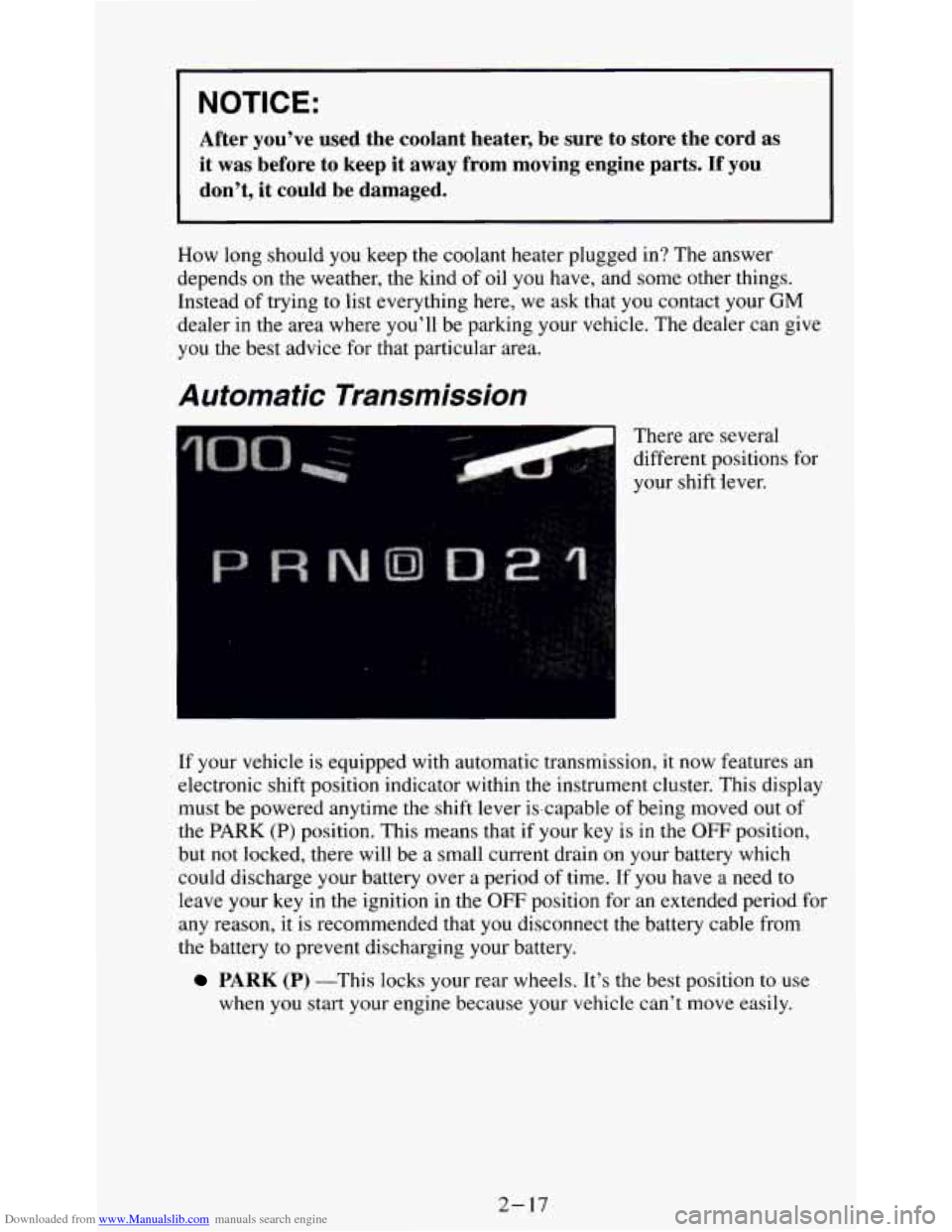
Downloaded from www.Manualslib.com manuals search engine I NOTICE:
After you’ve used the coolant heater, be sure to store the \
cord as
it
was before to keep it away from moving engine parts. If you
don’t, it could be damaged.
How long should you keep the coolant heater plugged in? The answer
depends
on the weather, the kind of oil you have, and some other things.
Instead of trying to list everything here, we ask that
you contact your GM
dealer in the area where you’ll be parking your vehicle. The dealer can give
you the best advice for that particular area.
Automatic Transmission
There are several
different positions for
I
your shift lever.
If your vehicle
is equipped with automatic transmission, it now features an
electronic shift position indicator within
the instrument cluster. This display
must be powered anytime the shift lever is-capable
of being moved out of
the
PARK (P) position. This means that if your key is in the OFF position,
but
not locked, there will be a small current drain on your battery which
could discharge your battery over a period of time. If you have
a need to
leave your key in the ignition in
the OFF position for an extended period for
any reason, it is recommended that you disconnect the battery cable from
the battery
to prevent discharging your battery.
PARK (P) -This locks your rear wheels. It’s the best position to use
when
you start your engine because your vehicle can’t move easily.
2-17
Page 107 of 354
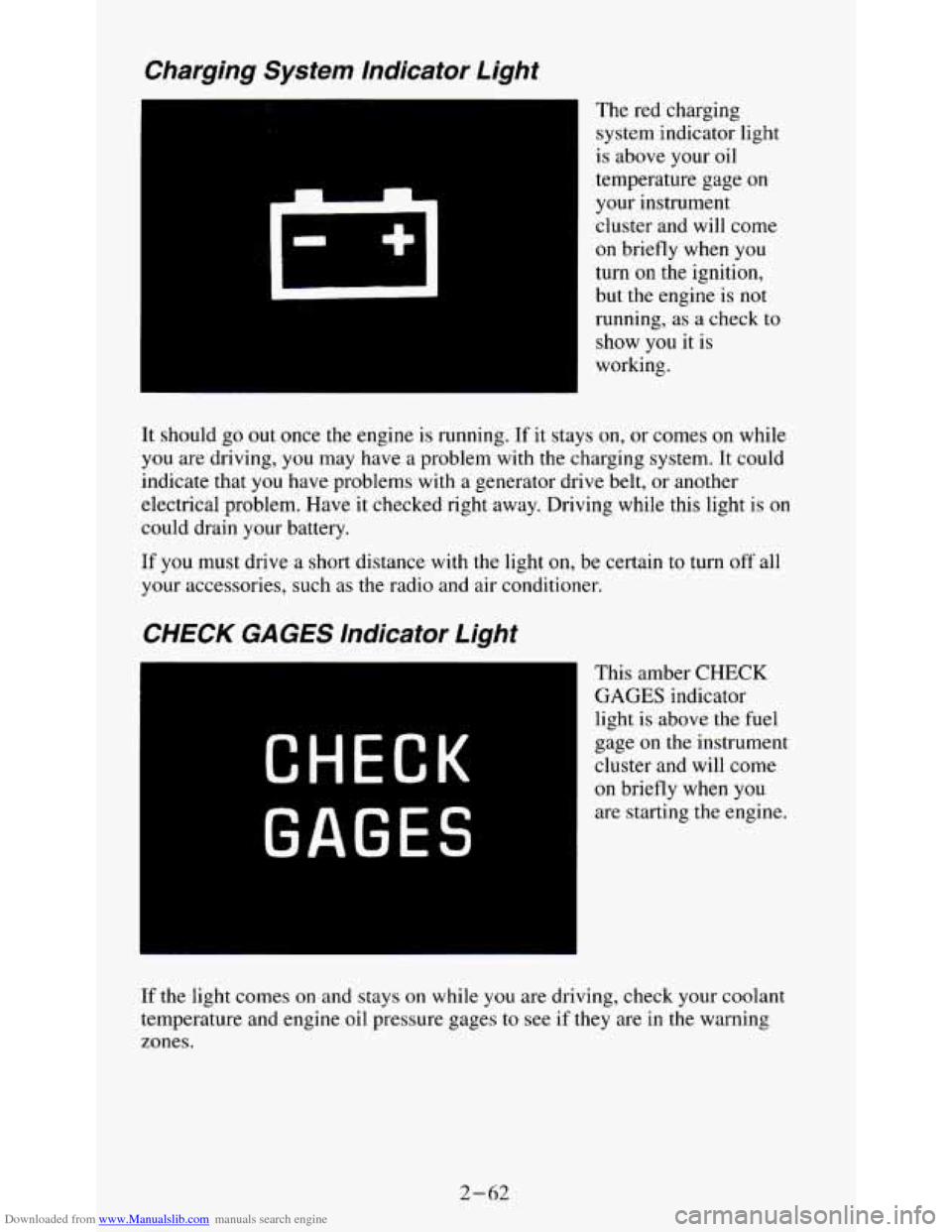
Downloaded from www.Manualslib.com manuals search engine Charging System lndicator Light
The red charging
system indicator light
is above your oil
temperature gage on
your instrument
cluster and will come
on briefly when you
turn
on the ignition,
but the engine is
not
running, as a check to
show you it is
working.
It should go
out once the engine is running. If it stays on, or comes on while
you are driving, you may have a problem with the charging system. It could
indicate that
you have problems with a generator drive belt, or another
electrical problem. Have it checked right away. Driving while this light is
on
could drain your battery.
If you must drive a short distance with the light on, be certain to turn off all
your accessories, such as the radio and air conditioner.
CHECK GAGES lndicator Light
CHECK
GAGES
This amber CHECK
GAGES indicator
light
is above the fuel
gage
on the instrument
cluster and will come
on briefly when you
are starting the engine.
If the light comes on and stays on while you are driving, check your coolant
temperature and engine oil pressure gages
to see if they are in the warning
zones.
2-62
Page 110 of 354
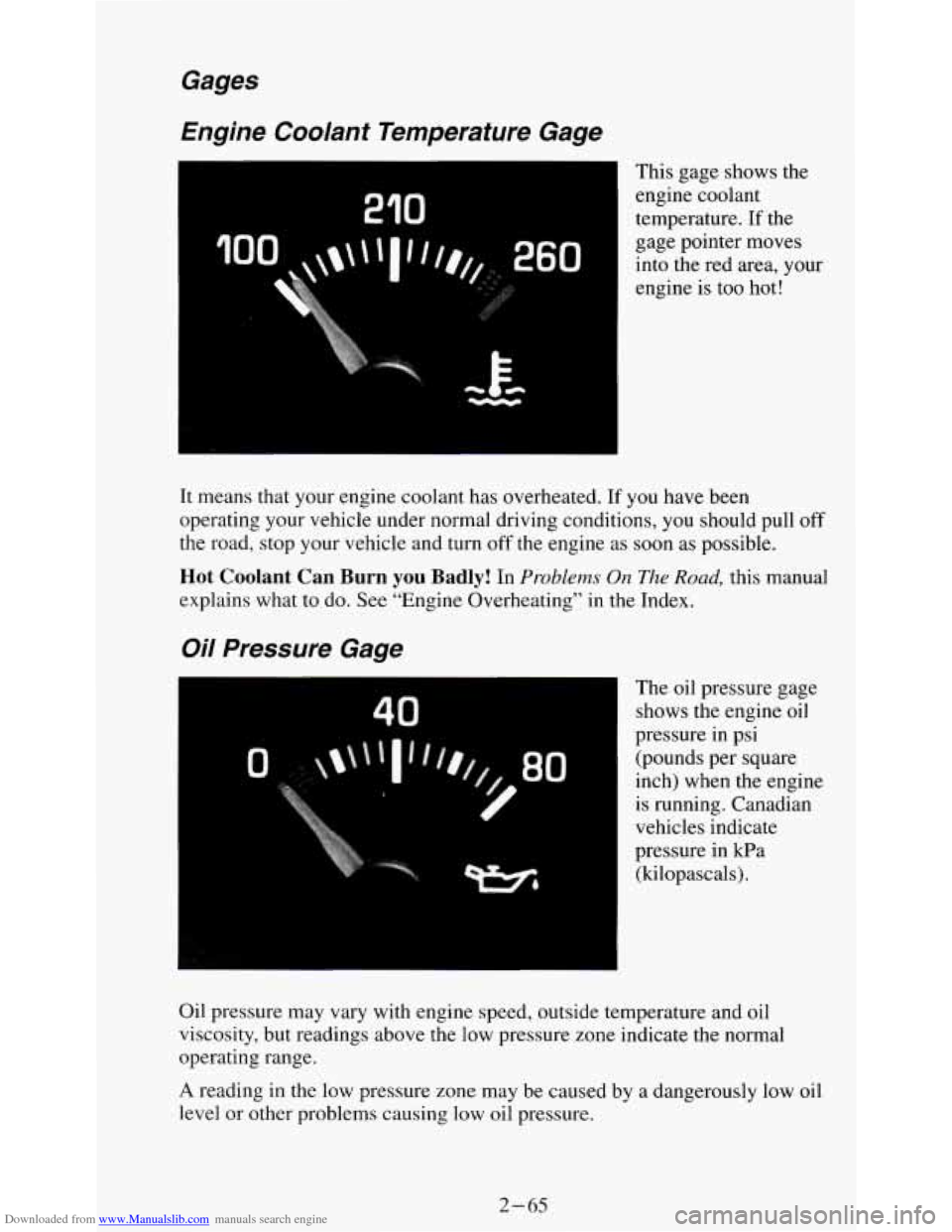
Downloaded from www.Manualslib.com manuals search engine Gages
Engine Coolant Temperature Gage
210
This gage shows the
engine coolant
temperature.
If the
gage pointer moves
into the red area, your
engine is too hot!
It means that your engine coolant has overheated.
If you have been
operating your vehicle under normal driving conditions,
you should pull off
the road, stop your vehicle and turn off the engine as soon as possible.
Hot Coolant Can Burn you Badly! In Problems On The Road, this manual
explains what to do. See “Engine Overheating” in the Index.
Oil Pressure Gage
The oil pressure gage
shows the engine oil
pressure in psi
(pounds per square
inch) when the engine
is running. Canadian
vehicles indicate
pressure
in kPa
(kilopascals).
Oil pressure may vary with engine speed, outside temperature and oil
viscosity, but readings above
the low pressure zone indicate the normal
operating range.
A reading in the low pressure zone may be caused by a aangerously low oil
level or other problems causing low oil pressure.
2-65
Page 116 of 354
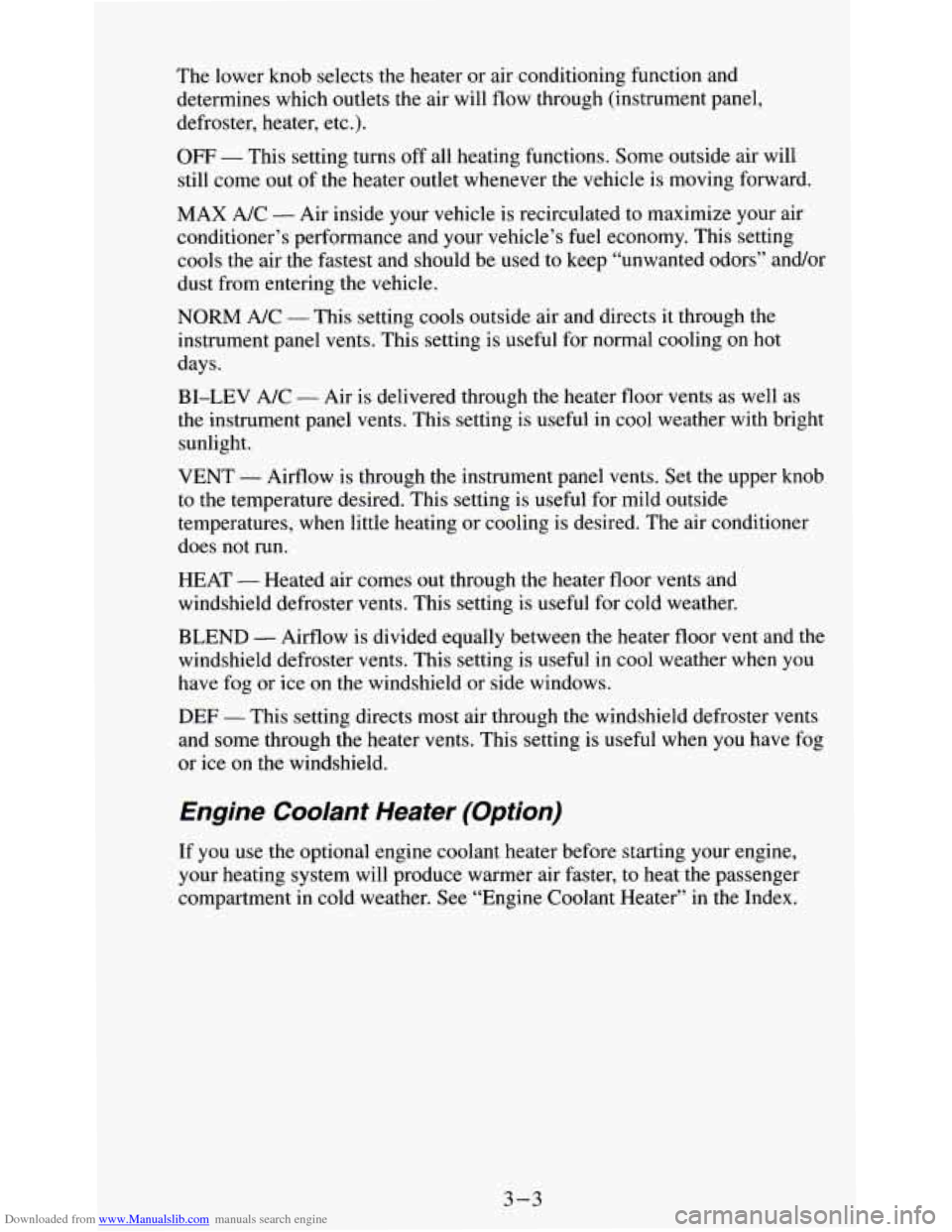
Downloaded from www.Manualslib.com manuals search engine The lower knob selects the heater or air conditioning function and
determines which outlets the air will flow through (instrument panel,
defroster, heater, etc.).
OFF - This setting turns off all heating functions. Some outside air will
still come out of the heater outlet whenever the vehicle is moving forward.
MAX A/C
- Air inside your vehicle is recirculated to maximize your air
conditioner’s performance and your vehicle’s fuel economy. This setting
cools the air the fastest and should be used to keep “unwanted odors” and/or
dust from entering the vehicle.
NORM A/C - This setting cools outside air and directs it through the
instrument panel vents. This setting is useful for normal cooling on hot
days.
BI-LEV A/C
- Air is delivered through the heater floor vents as well as
the instrument panel vents. This setting is useful in cool weather with bright
sunlight.
VENT - Airflow is through the instrument panel vents. Set the upper knob
to the temperature desired. This setting is useful for mild outside
temperatures, when little heating or cooling is desired. The air conditioner
does not run.
HEAT
- Heated air comes out through the heater floor vents and
windshield defroster vents. This setting is useful for cold weather.
BLEND
- Airflow is divided equally between the heater floor vent and the
windshield defroster vents. This setting
is useful in cool weather when you
have fog or ice on the windshield
or side windows.
DEF - This setting directs most air through the windshield defroster vents
and some through the heater vents. This setting is useful when you have fog
or ice on the windshield.
Engine Coolant Heater (Option)
If you use the optional engine coolant heater before starting your engine,
your heating system
will produce warmer air faster, to heat the passenger
compartment
in cold weather. See “Engine Coolant Heater” in the Index.
3-3
Page 164 of 354
Downloaded from www.Manualslib.com manuals search engine Know how to go uphill. You may want to shift down to a lower gear.
The lower gears help cool your engine and transmission, and you can
climb the hill better.
Stay in your own lane when driving on two-lane roads in hills or
mountains. Don’t swing wide or cut across the center of the road. Drive
at speeds that let you stay in your own lane.
As you go over the top of a hill, be alert. There could be something in
your lane, like a stalled car or an accident.
0 You may see highway signs on mountains that warn of special
problems. Examples are long grades, passing
or no-passing zones, a
falling rocks area, or winding roads. Be alert to these and take
appropriate action.
Winter Driving
Here are some tips for winter driving:
Have your vehicle in good shape for winter. Be sure your engine
coolant mix is correct.
You may want to put winter emergency supplies in your vehicle.
4-31